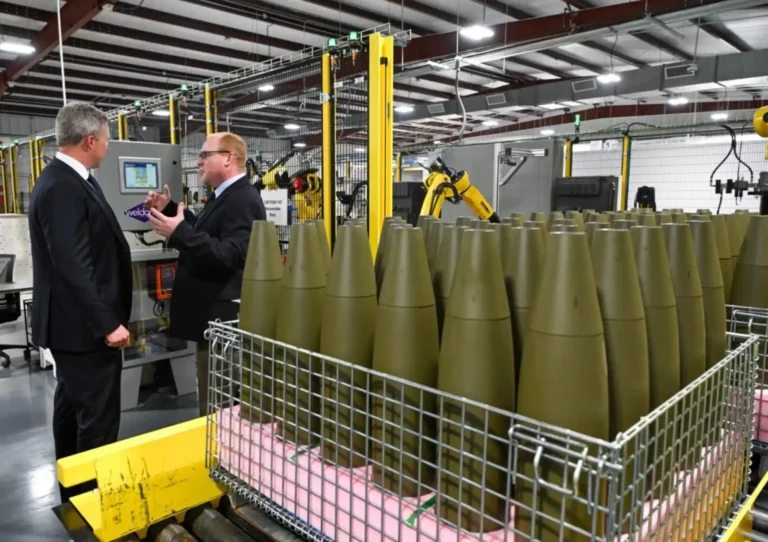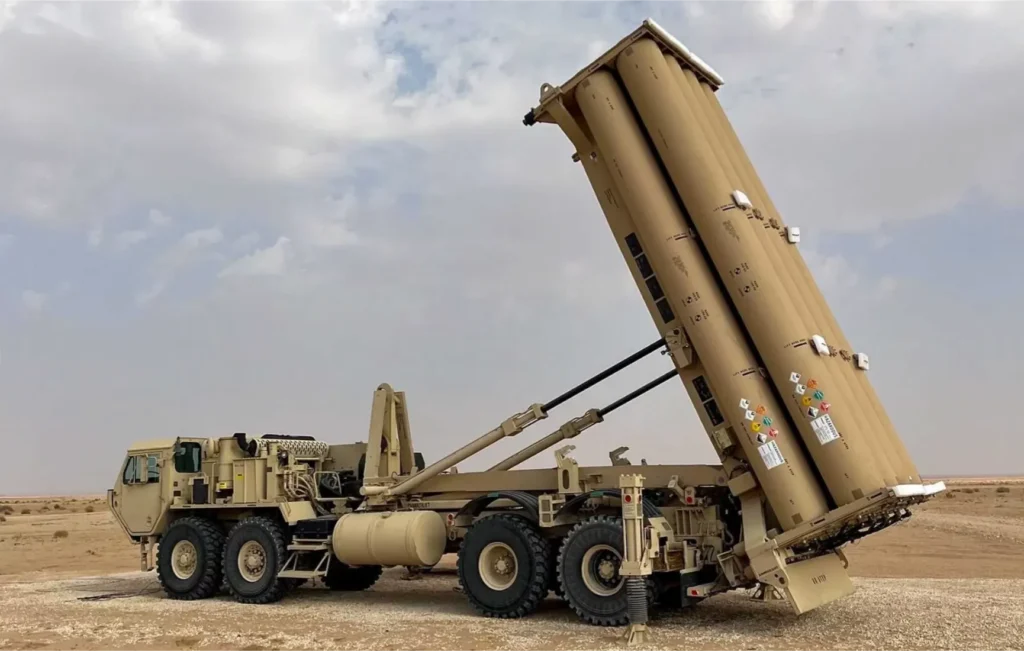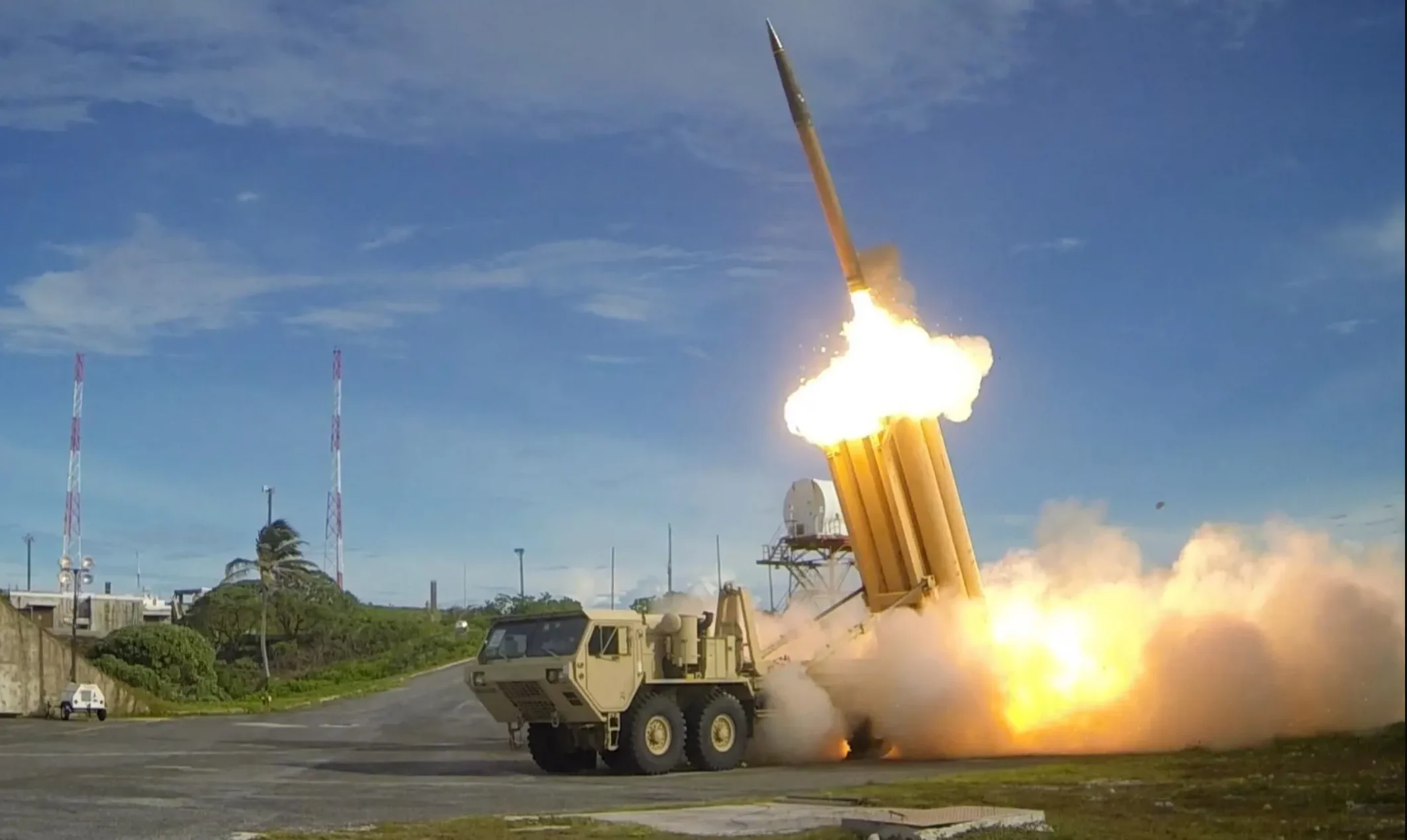Follow Us:

Share
In a world where missile threats are no longer distant possibilities but daily realities, nations are racing to shield their skies. One of the most advanced missile defense solutions standing at the frontline is the THAAD system, which is short for Terminal High Altitude Area Defense.
Developed by Lockheed Martin in collaboration with Raytheon, THAAD is a U.S. Army-operated air defense platform designed to intercept and destroy short to intermediate-range ballistic missiles during their final phase of flight—just before impact.
Unlike traditional systems that rely on explosives to neutralize threats, THAAD intercepts missiles using sheer kinetic energy, literally smashing into the incoming projectile at hypersonic speeds. This is known as a “hit-to-kill” approach, and it’s what makes the THAAD missile defense system both precise and deadly effective.
What separates THAAD from other missile systems like Patriot or Iron Dome is its altitude and speed. While Patriot is designed for lower-altitude threats, THAAD operates at much higher altitudes, giving it the ability to engage missiles further from their intended targets. This unique high-altitude capability significantly increases the chances of a successful intercept, providing what the military calls “layered defense.”

But what is the THAAD system exactly? How does THAAD work? This comprehensive guide explores every facet of this cutting-edge missile defense system—from its radar capabilities to THAAD interceptors, from THAAD’s range and missile speed to its global deployment footprint.
To understand how good THAAD really is, we have to look under the hood—at the raw performance data, engineering sophistication, and battlefield utility that make the THAAD missile system one of the most formidable tools in modern air defense.
From its lightning-fast interceptors to its game-changing radar, THAAD brings a blend of precision, power, and technology to every mission it’s assigned.
Unlike long-range strategic systems like the Ground-based Midcourse Defense (GMD), THAAD is optimized for intercepts in the terminal phase—when a ballistic missile is descending toward its target. Its effective intercept range is approximately:
This high-altitude reach gives THAAD a unique advantage: it can engage incoming missiles before they re-enter the atmosphere or during re-entry, depending on their trajectory. That extended vertical engagement zone makes it especially valuable for defending wide-area population centers, forward-deployed military bases, and critical infrastructure.
While THAAD is not a global shield, its regional coverage—when strategically deployed in layers with other systems—creates an air defense bubble that significantly complicates an enemy’s attack plans.
Speed is everything in missile defense. And THAAD interceptors are designed to close the gap with enemy missiles at a blinding pace.
To put that in perspective, it takes less than 90 seconds for a THAAD interceptor to travel its full 200 km range. That’s just about enough time to detect, classify, assign a launcher, fire the interceptor, and make mid-flight course corrections—all in a matter of seconds.
At such speeds, even a minor impact delivers massive kinetic energy, enough to vaporize an incoming warhead. That’s the core of THAAD’s hit-to-kill lethality—no explosives required.

Every successful intercept starts with a detection—and that’s where THAAD’s radar makes all the difference. Developed by Raytheon, the AN/TPY-2 radar is the technological crown jewel of the system.
Key Features:
The radar is capable of tracking hundreds of objects simultaneously, differentiating between real threats and decoys. It provides mid-course tracking data to THAAD missiles, enabling course corrections mid-flight, and feeds into a global network of missile warning and defense systems.
When deployed forward (separate from a THAAD battery), the radar acts as a strategic sensor, offering long-range surveillance for the broader military command structure. This forward-deployed radar in South Korea has, in fact, drawn concern from regional powers like China and Russia, who argue it could be used for surveillance deep within their borders—a testament to its far-reaching capabilities.

A full THAAD missile battery is a mobile, modular system that includes:
The launchers are truck-mounted and can be rapidly repositioned. This mobility means THAAD can adjust to shifting threats, unlike fixed-location defense systems.
A single THAAD battery can protect a vast area, but when multiple batteries are networked across a region, they create a layered, overlapping shield that’s nearly impenetrable by conventional ballistic missiles.
Understanding how THAAD works means understanding the science of modern missile interception and the split-second precision required to neutralize high-speed ballistic threats. THAAD, or Terminal High Altitude Area Defense, is engineered for one very specific purpose: to destroy enemy ballistic missiles in their terminal phase—the final moments before they strike their target. That sounds simple enough, but the mechanics behind the system are anything but.

Let’s break down the system into its core components and processes:
The first step in any missile defense operation is early detection, and THAAD’s capability begins with its powerful X-band radar, the AN/TPY-2, developed by Raytheon. This high-resolution radar can track incoming threats at ranges of over 1,000 kilometers (620 miles). Positioned forward on the battlefield or near high-value assets, this radar scans the skies 24/7, constantly searching for missile launches.
Once a launch is detected, the radar begins tracking the projectile’s trajectory in real time. It distinguishes between decoys, debris, and actual threats—an essential task when adversaries attempt to overwhelm defense systems with multiple objects or false targets.
This tracking data is then fed into the THAAD Fire Control and Communications (TFCC) system, the brains of the operation, which calculates the exact point of interception and assigns a missile from the nearest launcher.
Once a threat is confirmed, decisions have to be made in seconds. THAAD’s battle management system uses advanced algorithms to predict the missile’s path, assess the threat level, and prioritize targets if more than one missile is detected.
THAAD systems are fully integrated with other missile defense networks, such as Patriot batteries, Aegis BMD, and the global missile warning network. This layered defense means that if a threat is missed at a higher altitude, lower-tier systems can attempt a second intercept, providing redundancy and a higher probability of success.
Once the engagement decision is made, the order is given, and a THAAD missile interceptor is launched. Each THAAD missile is about 6.2 meters long, weighs around 900 kilograms, and is powered by a solid-propellant rocket motor. It does not carry an explosive warhead—its destructive power lies entirely in its speed and accuracy.
Traveling at speeds of up to Mach 8 (approximately 9,800 km/h or 6,100 mph), the THAAD missile races to its projected collision point, guided by both inertial navigation and real-time updates from the radar. In the final moments, its infrared seeker takes over, making micro-adjustments to steer the interceptor directly into the enemy missile.
This “hit-to-kill” approach is incredibly challenging to execute. Imagine trying to hit a bullet with another bullet—except both bullets are traveling at several times the speed of sound, and one of them may be maneuvering to avoid being hit. Yet, in controlled tests and real-world scenarios, THAAD intercept success rates have consistently ranged between 80-100%, according to U.S. Department of Defense reports.
| Component | Function |
| AN/TPY-2 Radar | Detects and tracks enemy missiles |
| THAAD Fire Control Unit | Calculates trajectory and manages engagement |
| THAAD Launcher | Holds and fires interceptors |
| THAAD Interceptor Missile | Destroys targets with kinetic impact |
One of THAAD’s greatest advantages is its mobility. The entire THAAD missile battery can be airlifted and deployed rapidly anywhere in the world. Once on-site, it can be operational within hours. This means THAAD can be repositioned as threats evolve—whether to deter aggression in the Indo-Pacific, protect oil infrastructure in the Middle East, or reinforce allies in Eastern Europe.
THAAD systems have already been deployed in strategic locations such as:
This agility makes THAAD not just a defensive tool, but also a political signal—its arrival in a region often serves as a message that the U.S. is serious about protecting its interests and allies.
When it comes to missile defense, effectiveness isn’t measured by speculation—it’s measured in successful intercepts, combat readiness, and reliability under pressure. The Terminal High Altitude Area Defense (THAAD) system has spent over two decades proving itself through rigorous testing and real-world deployments. But how effective is THAAD, really?
Since its inception, the THAAD missile defense system has undergone a series of live-fire tests under various conditions, simulating the unpredictable dynamics of real-world threats. According to data from the Missile Defense Agency (MDA), as of 2023, THAAD has achieved 16 successful intercepts in 16 attempts in controlled testing environments. These tests include engagements with short- and medium-range ballistic missile targets launched at high speeds and from diverse angles.
What makes these tests especially notable is that they involve no explosive warhead. Instead, the THAAD interceptor relies on its ability to hit the incoming missile head-on, a concept that drastically reduces collateral damage and makes the system ideal for defending populated areas or critical infrastructure.
Here’s a quick look at some milestone tests:
| Test Date | Location | Intercept Outcome | Threat Type |
| July 2006 | White Sands, NM | Successful | Medium-range ballistic missile |
| October 2012 | Pacific Range | Successful | Multiple simultaneous targets |
| July 2017 | Alaska | Successful | North Korean-type missile replica |
| August 2019 | Kodiak, AK | Successful | Complex trajectory target |
These results are not only impressive but also critical for allies who depend on THAAD batteries deployed in high-threat zones.
While tests offer controlled assurance, real-world deployment is the true litmus test of any defense system. THAAD has been forward-deployed in several countries, and its radar has helped track and defend against actual hostile launches.
In Saudi Arabia, THAAD systems played a key role in intercepting Iranian ballistic missiles aimed at critical oil infrastructure. In South Korea, the deployment of THAAD has been central to the country’s defense against North Korea’s Hwasong missile program, a capability that has grown increasingly advanced in recent years.
Though the U.S. military remains tight-lipped about specific intercept numbers in combat scenarios due to operational security, regional partners have consistently requested more THAAD batteries, suggesting high levels of confidence in the system’s effectiveness.
A major contributor to THAAD’s success is its hit-to-kill technology, which is a rarity in global missile defense. While other systems may rely on proximity-detonated warheads or fragmentation, THAAD’s precision strike approach leaves no margin for error, but also no room for failure.
This method has some critical advantages:
Another reason THAAD is considered highly effective is due to its interoperability with other missile defense systems. It forms part of a layered missile defense strategy, where THAAD handles upper-tier threats, while systems like Patriot PAC-3 deal with lower-altitude intercepts.
This approach significantly improves the chances of intercepting even saturation attacks, where multiple missiles are fired simultaneously to overwhelm defenses. THAAD’s radar and command system can also be linked with Aegis ships, NATO air defenses, and space-based early warning satellites, forming a global missile defense network.
No system is perfect, and THAAD has its limitations:
However, in its specialized niche—defending against high-speed ballistic threats in the final moments of flight—THAAD has few, if any, peers.
Modern missile defense doesn’t come cheap. The THAAD missile system is a cutting-edge defense platform, and its price tag reflects that. From development and procurement to deployment and maintenance, THAAD represents one of the most significant defense investments a country can make.
Yet despite the high cost, global demand for the system continues to grow year over year, proving that when it comes to national defense, reliability and effectiveness often outweigh price.
The total cost of a single THAAD battery is estimated at $800 million to $1.4 billion, depending on configuration and support systems. That includes:
Let’s break it down further:
| Component | Estimated Unit Cost (USD) |
| THAAD Interceptor Missile | $3 million per missile |
| THAAD Launcher | $10–12 million |
| AN/TPY-2 Radar | $500–600 million |
| Total Battery (System Level) | $1–1.4 billion |
Each THAAD interceptor costs roughly $3 million, which is significantly more expensive than short-range interceptors like those used in Israel’s Iron Dome ($50,000–$100,000 per missile), but cheaper than the SM-3 interceptors used in the Navy’s Aegis system (up to $15 million each).
However, the true value of THAAD lies in what it protects: critical infrastructure, population centers, oil fields, airbases, and entire regions. From that perspective, its cost becomes not just justifiable—but essential.
Despite its high cost, multiple countries have either acquired THAAD or expressed interest in doing so. The reason is simple: no other system in the world currently offers THAAD’s blend of mobility, altitude, range, and real-world combat success.
In 2017, the U.S. approved a $15 billion sale of THAAD systems to Saudi Arabia, marking one of the largest foreign military sales involving missile defense in history. The UAE deal was similarly significant, valued at around $3.5 billion.
This trend shows a growing appetite for high-tier ballistic missile defense, especially among nations located near missile-capable adversaries. Many of these governments see THAAD not only as a defense investment but also as a political one—strengthening ties with the United States and integrating more deeply into American military networks.
From the mountains of South Korea to the deserts of the Middle East, the THAAD missile defense system stands as one of the most advanced and strategically vital tools in the world’s missile defense arsenal. It’s fast, precise, mobile, and—most importantly—battle-tested.
THAAD’s effectiveness is rooted in technological sophistication—its ability to detect, track, and destroy ballistic missiles at incredible speeds and altitudes. The system fills a critical gap in layered missile defense strategies by targeting threats during their terminal phase, giving militaries a final opportunity to neutralize enemy missiles before impact. And with a proven intercept success rate, a hit-to-kill kinetic approach, and global integration with other systems like Patriot and Aegis, THAAD isn’t just good—it’s elite.
Yet what truly elevates THAAD is its strategic value. Wherever it is deployed, THAAD sends a clear geopolitical message: this region is protected, not just with missiles but with U.S. backing, international cooperation, and technological dominance. Its radar reach, range, and response time make it both a sword and a shield—equally useful for deterrence and defense.
Of course, the system isn’t without limitations. THAAD is not designed to intercept cruise missiles or maneuverable hypersonic glide vehicles. It’s also a high-cost investment, both in acquisition and operational logistics. But in a world where the cost of vulnerability is counted not just in dollars but in lives, the price tag becomes easier to justify.
So, is THAAD the future of missile defense? In many ways, it already is. But perhaps more accurately, it is a cornerstone of the present, built with the foresight and flexibility to adapt to future threats. As missile technology evolves, so too will the systems designed to counter it—and if the global demand, test record, and operational deployment of THAAD are any indicators, this system will remain at the forefront for years to come.
Share
Defense Feeds is publication focusing on informing, engaging, and empowering the world by providing accurate information from defense technology.
Powered by Defense Feeds © 2025 – All rights reserved.